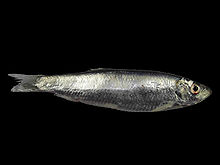European sprat
| European sprat | |
|---|---|

| |
| Scientific classification | |
| Kingdom: | |
| Phylum: | |
| Class: | |
| Order: | |
| Family: | |
| Genus: | |
| Species: | S. sprattus
|
| Binomial name | |
| Sprattus sprattus | |
| Synonyms[1] | |
| |
The European sprat (Sprattus sprattus), also known as bristling, brisling or skipper, is a species of small marine fish in the herring family Clupeidae. Found in European waters, it has silver grey scales and white-grey flesh. Specific seas in which the species occurs include the Irish Sea, Black Sea, Baltic Sea and Sea of the Hebrides.[2] The fish is the subject of fisheries, particularly in Scandinavia, and is made into fish meal, as well as being used for human consumption. The fish has about 12% fat in its flesh and is a source of many vitamins. When used for food it can be canned, salted, fried, grilled, baked, marinated and broiled.
Taxonomy
This fish was first described by Carl Linnaeus in 1758 in the 10th edition of Systema Naturae. He called it Clupea sprattus, but it was later transferred to the genus Sprattus.[1] Three subspecies are recognised; S. sprattus balticus from the Baltic Sea; S. sprattus phalericus from the Mediterranean, Adriatic and Black Seas and S. sprattus sprattus from the eastern Atlantic.[3]
Description
The European sprat is a small fish growing to a maximum length of 16 cm (6.3 in), but more often in the 8 to 12 cm (3 to 5 in) range. It is fairly elongate and somewhat laterally compressed, with a keel-like row of sharp scales along the belly. The lower jaw projects slightly, there are seldom any vomerine teeth on the roof of the mouth and the hind edge of the gill covers is smoothly rounded, without any fleshy protuberances. The dorsal fin has no spines and 13 to 21 soft rays while the anal fin has no spines and 12 to 23 soft rays. The origin of the pelvic fins, which have seven (occasionally eight) soft rays, are immediately below or in front of the origin of the dorsal fin. This fish has a bluish or greenish back and silvery flanks, with no dark spotting.[3][4]
Distribution
The European sprat is native to the northeastern Atlantic Ocean. Its range includes the Baltic Sea, the North Sea, southern Norway and Sweden, round the coasts of the British Isles, the Iberian Peninsula, Morocco, the Mediterranean Sea, the Adriatic Sea and the Black Sea. It is a schooling fish and migrates between its winter feeding grounds and its summer breeding grounds. It also makes vertical migrations, rising to near the surface at night to feed.[5]
Ecology
This fish is sometimes parasitised by a copepod, the sprat eye-maggot (Lernaeenicus sprattae) which burrows into its eye and causes loss of visual acuity or even blindness. Heavy infestations can kill the fish.[6]
As food
Young sprats are commonly known as brisling. Canned sprats (usually smoked) are available in many north European countries, including the Baltic states, Scandinavia, Ireland, Germany, Poland and Russia. They are an important Latvian export.[citation needed]
References
- ^ a b c Bailly, Nicolas (2018). "Sprattus sprattus (Linnaeus, 1758)". WoRMS. World Register of Marine Species. Retrieved 10 August 2018.
- ^ C.Michael Hogan, (2011) Sea of the Hebrides Archived May 24, 2013, at the Wayback Machine. Eds. P. Saundry & C.J.Cleveland. Encyclopedia of Earth. National Council for Science and the Environment. Washington DC.
- ^ a b "Sprat: Sprattus sprattus". Fishes of the NE Atlantic and the Mediterranean. Marine Species Identification Portal. Retrieved 10 August 2018.
- ^ "Sprattus sprattus (Linnaeus, 1758)". FishBase. Retrieved 10 August 2018.
- ^ "Sprattus sprattus (Linnaeus, 1758)". Species Fact Sheets. FAO. Retrieved 10 August 2018.
- ^ Rameshkumar, Ganapathy; Ravichandran, Samuthirapandian (2012). "Lernaeenicus sprattae (Crustacea: Copepoda) on Hemiramphus far". Middle-East Journal of Scientific Research. 11 (9): 1212–1215. doi:10.5829/idosi.mejsr.2012.11.09.64157.
{{cite journal}}: CS1 maint: multiple names: authors list (link)




